Key takeaways:
- Inclusivity in fandoms enhances the experience by valuing diverse voices and promoting connections among fans.
- Creating safe and welcoming spaces fosters open discussions, allowing fans to share personal stories and perspectives.
- Highlighting underrepresented artists and encouraging diverse narratives enriches the musical community and deepens appreciation for different backgrounds.
- Engaging in meaningful conversations can lead to empathy, understanding, and a supportive environment within fandoms.
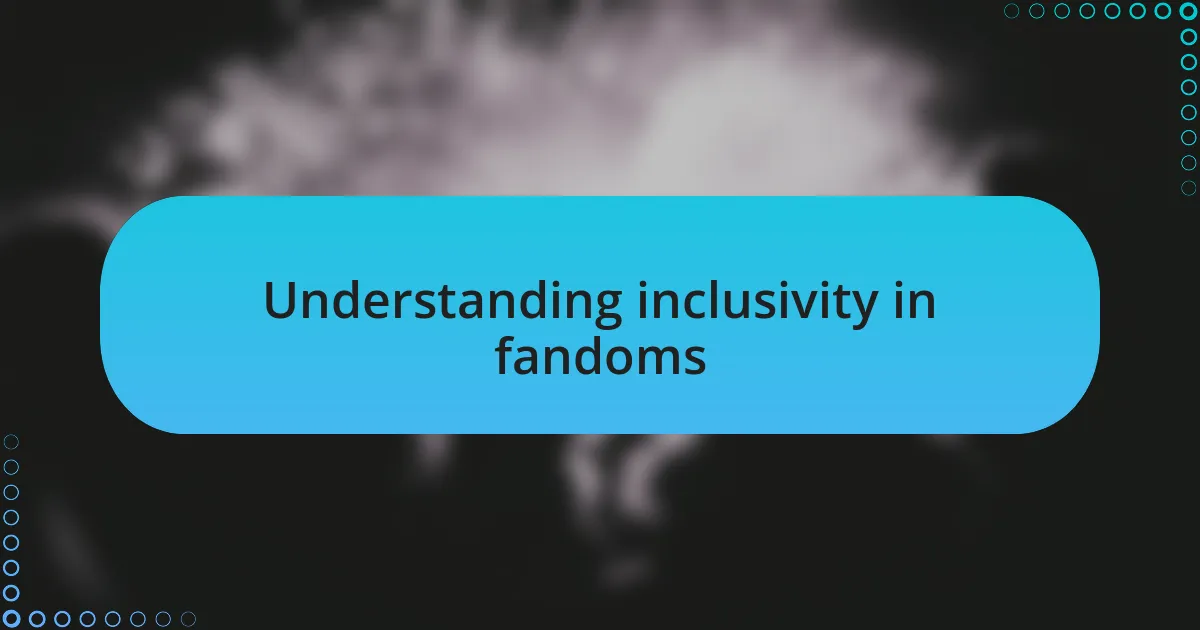
Understanding inclusivity in fandoms
Inclusivity in fandoms means creating a space where everyone, regardless of their background, feels welcomed and valued. I remember attending a local music event where fans from different cultures united over a shared love for a band. The energy was palpable; I realized that when we embrace our differences, we enhance our collective experience. Have you ever felt that rush of connection when surrounded by people who understand your passion?
Moreover, inclusivity isn’t just about physical presence; it’s also about listening and amplifying diverse voices within the community. I once participated in an online discussion where a fan shared their perspective on how cultural influences shaped our favorite band’s music. Hearing their story transformed my appreciation for the band, showing me how much richer fandom experiences can be when we make room for varied perspectives. Have you taken time to truly listen to different narratives in your fandom?
Finally, it’s essential to acknowledge the barriers that some fans face in feeling included. I vividly recall a time when I hesitated to engage in discussions due to fears of being judged for my preferences. That hesitancy is common, and it drives home the need for safe spaces where everyone can express their thoughts openly. How can we foster environments that encourage authentic conversations about our shared love for music?
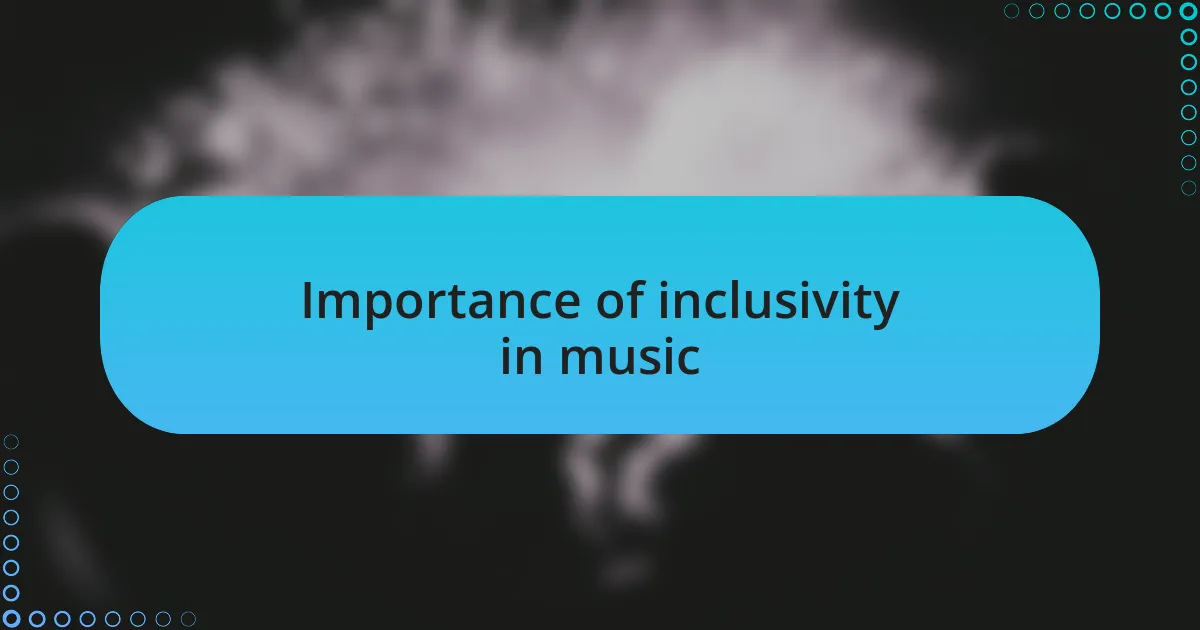
Importance of inclusivity in music
Inclusivity in music is crucial because it allows for a richer tapestry of creativity and expression. I’ve noticed how bands that invite diverse influences to the table often create melodies and lyrics that resonate deeply across various cultures. Isn’t it fascinating how a single song can evoke a unique emotional response for someone from a different background?
When I attended a concert featuring artists from different genres, I felt the power of inclusivity firsthand. The collaboration on stage created an atmosphere of unity and celebration that brought tears to my eyes. This shared experience reminded me that music is a universal language, one that thrives on diverse contributions. Have you ever experienced that moment when an unexpected collaboration changes your perception of an entire genre?
Moreover, embracing inclusivity can lead to a profound sense of belonging among fans. I recall a time when I met a fellow concertgoer who had a completely different taste in bands, yet we discovered common ground in the essence of our favorite songs. This connection opened my eyes to the idea that everyone has something valuable to offer, and it challenges us to appreciate the full spectrum of music. How often do we consider the stories behind the melodies we love?
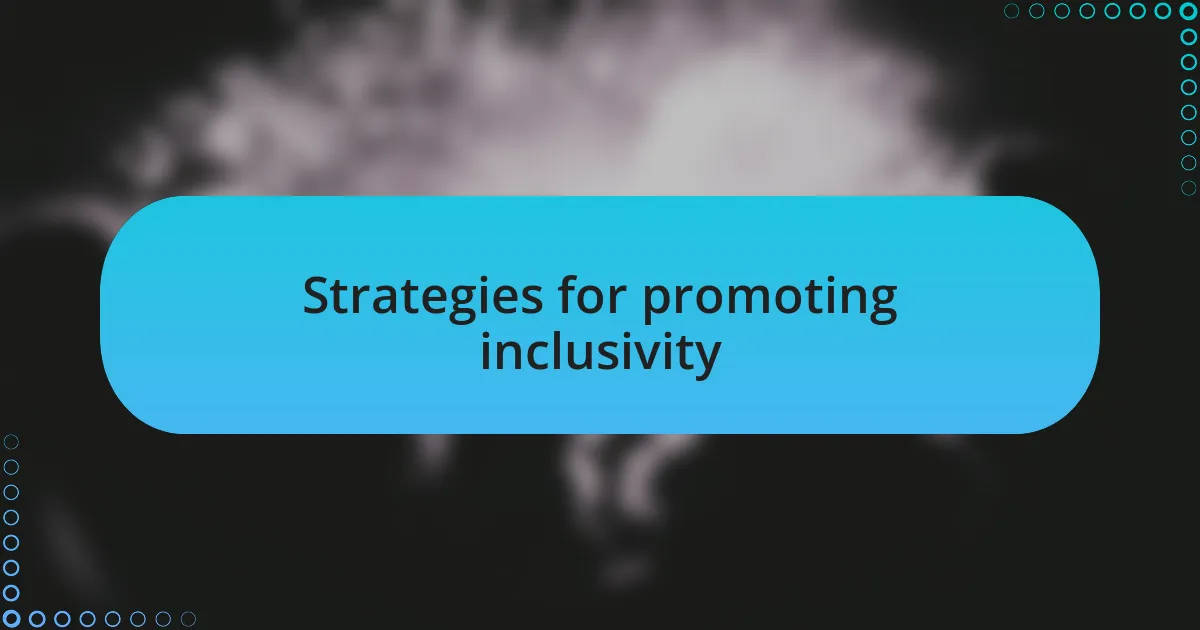
Strategies for promoting inclusivity
Creating an inclusive environment in fandom starts with intentional programming and events. For instance, when I organized a community listening party, I made sure to feature artists from underrepresented backgrounds. This not only diversifies our playlist but allows fans to share their experiences related to those artists’ messages. It’s amazing how just a simple event can open doors to deeper dialogue among fans. Have you ever felt that thrill when discovering a new artist that mirrors your own experiences?
Engagement on social media also plays a pivotal role in promoting inclusivity. I have found that actively sharing stories and content that highlight diverse voices fosters a sense of community. By encouraging fans to engage in conversations about their favorite tracks and artists, we create a welcoming space where everyone feels heard. It makes me wonder—how often do we take the time to amplify voices that might not get the spotlight they deserve?
Another effective strategy is collaborating with local organizations that advocate for inclusivity. In one initiative, I partnered with a non-profit focused on youth empowerment through music. Working together, we developed workshops that not only taught music skills but also emphasized the importance of representation. The joy I witnessed in the young participants’ faces was unforgettable. It left me reflecting on how impactful it is to create avenues that empower the next generation of artists and fans alike.
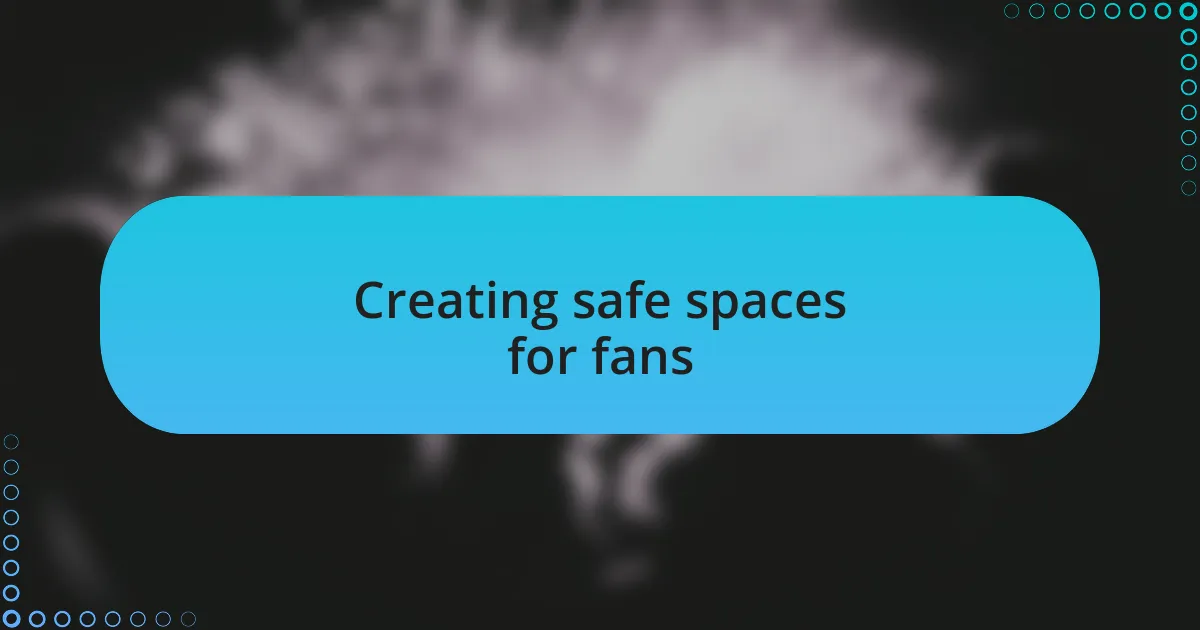
Creating safe spaces for fans
Creating safe spaces for fans is essential for fostering genuine connections. I remember attending a pop-up event dedicated to a fandom I deeply admire. Everyone was encouraged to share their stories and experiences, which quickly turned into a heartwarming exchange of vulnerability and support. Isn’t it incredible how these shared moments can create a sense of belonging that fans often miss in their everyday lives?
One thing I’ve noticed is that the layout and atmosphere of an event can significantly impact how safe fans feel. At a small concert I attended, the organizers explicitly stated their commitment to inclusivity and respect, which immediately put everyone at ease. It made me think—how important is it to set clear guidelines that encourage positive interactions among fans?
Creating virtual spaces also has its challenges, but I always try to implement clear moderation policies in online fandom forums. During one intense discussion, we faced a backlash over differing opinions, but with thoughtful moderation, we turned that moment into an opportunity for growth. How can we ensure that online environments reflect the same safety and respect we aim to create in physical spaces?
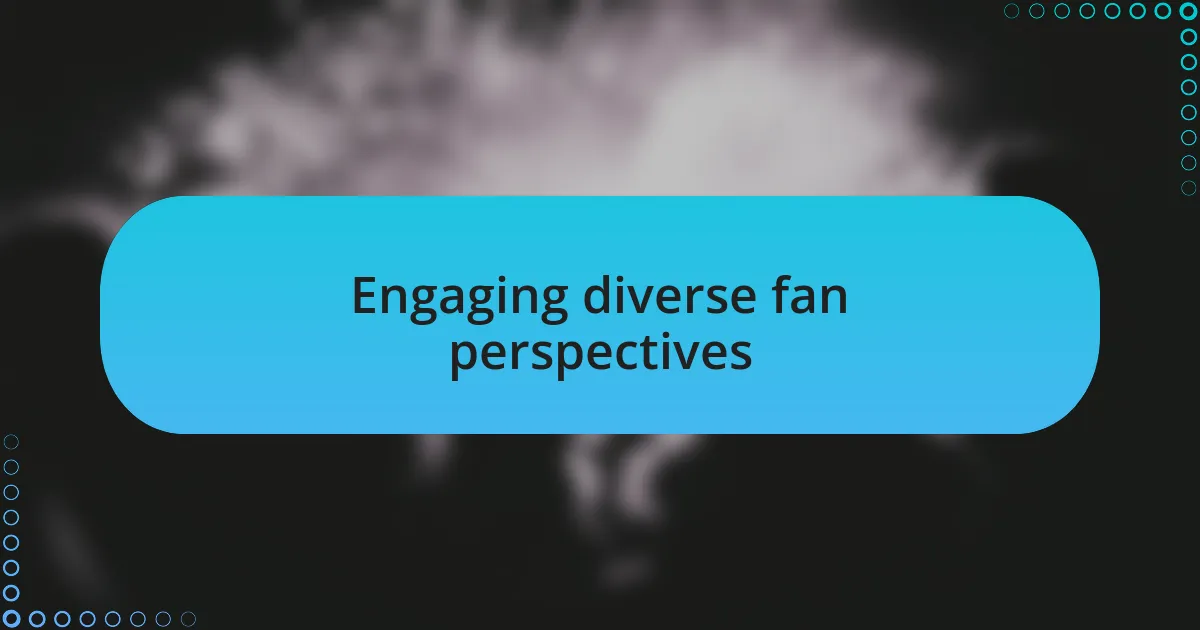
Engaging diverse fan perspectives
Engaging diverse fan perspectives is crucial for enriching the overall fandom experience. I vividly recall a discussion panel where fans from different backgrounds shared their interpretations of a band’s lyrics. It was fascinating to see how cultural backgrounds shaped their perspectives, leading to insights I had never considered before. How can we harness these unique viewpoints to deepen our understanding of the artistry involved?
During a recent online forum discussion, I was pleasantly surprised when a fan shared how a particular song resonated with their personal journey as a member of an underrepresented community. The authenticity in their voice sparked a series of affirming responses from others who felt similarly. Isn’t it powerful how one story can create an avalanche of shared experiences that bind us together?
In my experience, actively encouraging fans to voice their thoughts not only fosters inclusivity but also promotes empathy within the community. I once moderated a conversation asking fans to discuss what the band’s music meant to them. This simple prompt led to a realization: everyone has a story worth telling, and all of these narratives contribute to a richer, more vibrant fandom landscape. So how do we continue to amplify these diverse voices and make everyone feel heard?
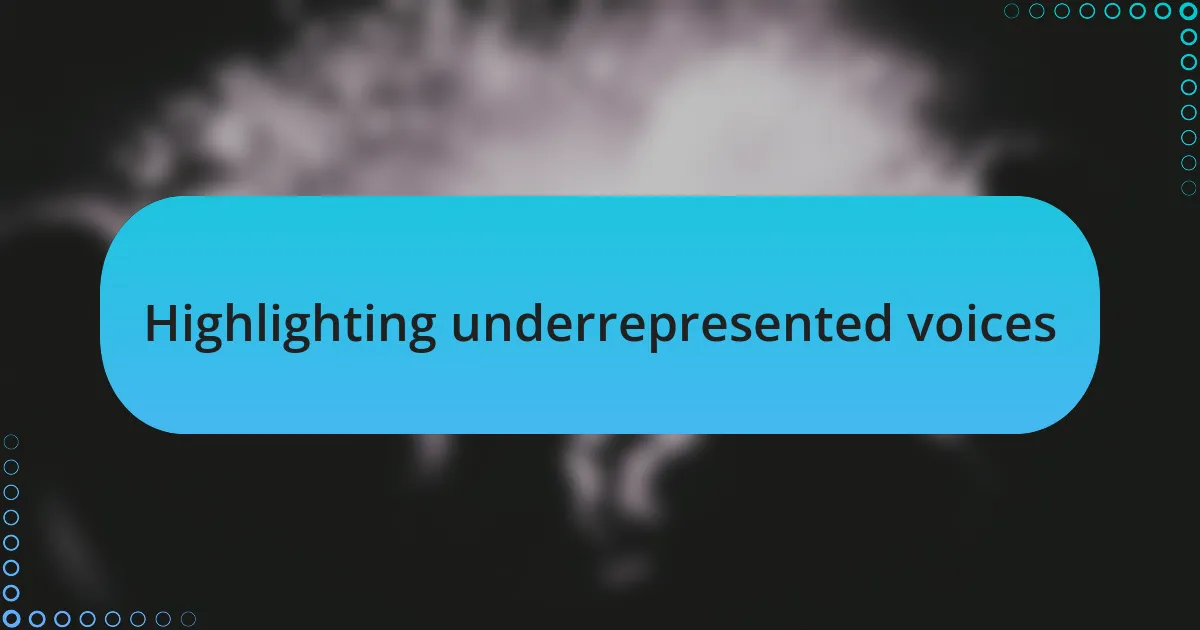
Highlighting underrepresented voices
Highlighting underrepresented voices within fandom is incredibly important. I remember attending a concert where the opening act was a local artist from a marginalized background. The crowd’s reaction was a testament to the power of representation; it was clear that her story and artistry resonated deeply with many in attendance. How often do we overlook these gems simply because they haven’t yet been given a platform?
Once, while exploring an online fan community, I stumbled upon a thread dedicated to discussing the challenges faced by fans from various underrepresented groups. A member shared their experience as a queer fan and how certain songs provided solace during difficult times. It struck me how essential it is to shine a light on these narratives, as they can foster solidarity and understanding. Isn’t it amazing how sharing these personal experiences can ignite feeling and create connections among fans?
Engaging with underrepresented artists and their stories can not only enrich our understanding of music but also transform our community. I recall collaborating on a playlist that included songs from diverse voices, and the feedback was overwhelming. Fans eagerly shared why these tracks mattered to them, deepening our collective appreciation for the nuances in our musical fandom. How can we create more spaces for these voices to be heard, allowing everyone to feel a part of the musical journey?

Sharing personal stories of inclusivity
There was a time when I attended a music festival that featured a diverse lineup, and it was not just the artists on stage that caught my attention. I found myself in a discussion with a group of fans who shared how certain performances helped them embrace their identities. One fan spoke movingly about how a particular song enabled them to come out to their friends and family. It made me wonder: how many of us have songs that serve as lifelines during pivotal moments in our lives?
I vividly recall a virtual jam session organized by a fan group, where participants were encouraged to share their personal stories tied to their favorite tracks. One participant shared how a song by a Black artist inspired her to advocate for social justice issues in her school. Listening to her story not only deepened my respect for that artist’s work but also propelled me to think more critically about the social impact of music in our lives and communities. Isn’t it astonishing how a melody can resonate so deeply and become a catalyst for change?
In another instance, during a community meet-up, I overheard a conversation between two fans who bonded over their shared experiences as disabled music lovers. They exchanged stories about the accessible features at their favorite venues, highlighting both their challenges and triumphs. It made me realize that sharing these personal stories not only enriches our musical experiences but also builds a network of empathy and support. Do we truly appreciate how these connections can lead to a more inclusive fandom? The answer is a resounding yes, and it’s something that I believe we all can contribute to.